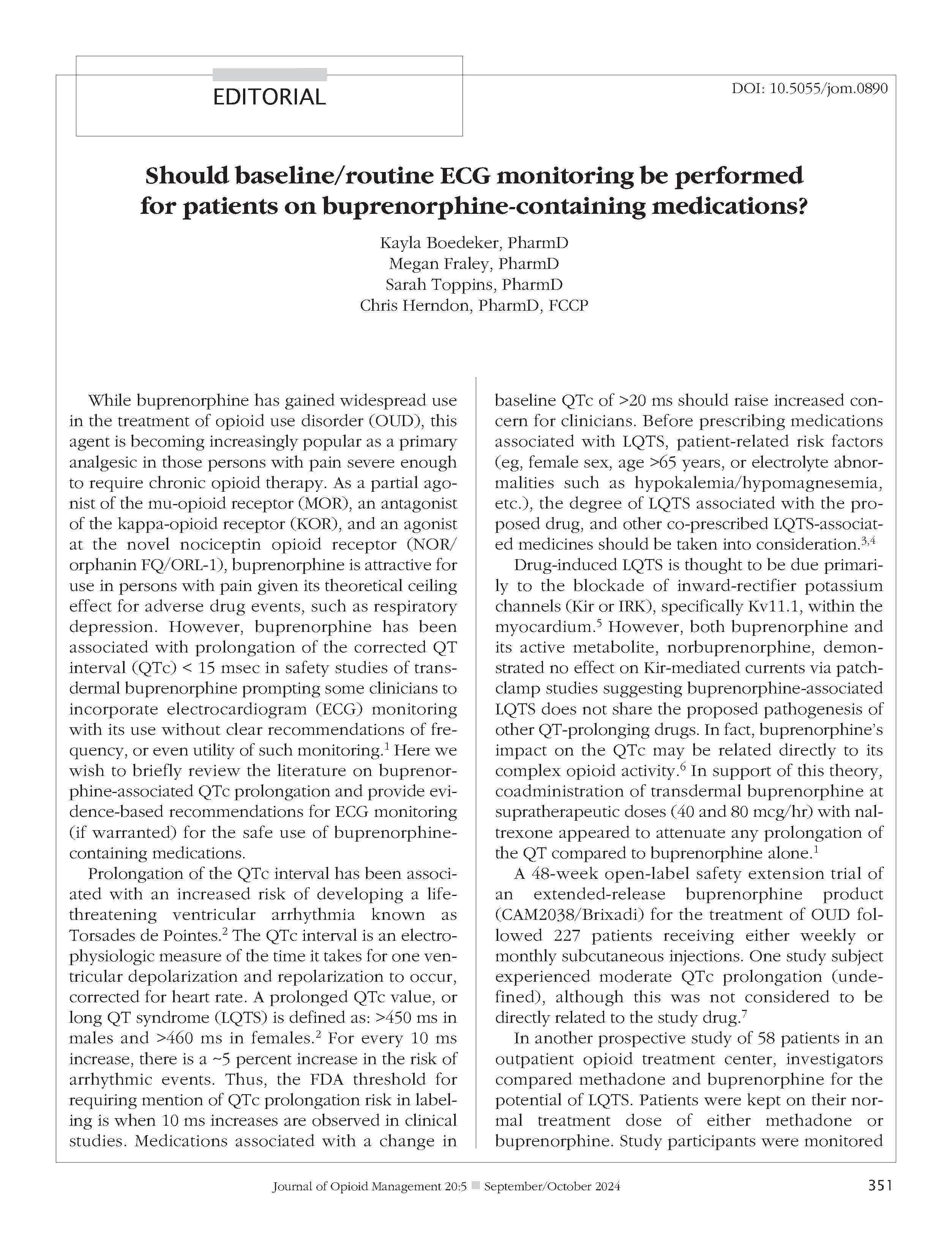Should baseline/routine ECG monitoring be performed for patients on buprenorphine-containing medications?
DOI:
https://doi.org/10.5055/jom.0890Keywords:
buprenorphine, ECG monitoringAbstract
While buprenorphine has gained widespread use in the treatment of opioid use disorder (OUD), this agent is becoming increasingly popular as a primary analgesic in those persons with pain severe enough to require chronic opioid therapy.
References
Harris SC, Morganroth J, Ripa SR, et al.: Effects of buprenorphine on QT intervals in healthy subjects: results of 2 randomized positive- and placebo-controlled trials. Postgrad Med. 2017; 129(1): 69-80. DOI: 10.1080/00325481.2017.1270156. DOI: https://doi.org/10.1080/00325481.2017.1270156
Giudicessi JR, Noseworthy PA, Ackerman MJ: The QT Interval: An Emerging Vital Sign for the Precision Medicine Era? Circulation. 2019; 139(24): 2711-2713. DOI: 10.1161/CIRCULATIONAHA.119.039598. DOI: https://doi.org/10.1161/CIRCULATIONAHA.119.039598
Khatib R, Sabir FRN, Omari C, et al.: Managing drug-induced QT prolongation in clinical practice. Postgrad Med J. 2021; 97(1149): 452-458. DOI: 10.1136/postgradmedj-2020-138661. DOI: https://doi.org/10.1136/postgradmedj-2020-138661
Drew BJ, Ackerman MJ, Funk M, et al.: Prevention of torsade de pointes in hospital settings: A scientific statement from the American heart association and the American college of cardiology foundation. Circulation. 2010; 121(8): 1047-1060. DOI: 10.1161/CIRCULATIONAHA.109.192704. DOI: https://doi.org/10.1161/CIRCULATIONAHA.109.192704
Darpo B, Zhou M, Bai SA, et al.: Differentiating the Effect of an Opioid Agonist on Cardiac Repolarization from m-Receptor-mediated, Indirect Effects on the QT Interval: A Randomized, 3-way Crossover Study in Healthy Subjects. Clin Ther. 2016; 38(2): 315-326. DOI: 10.1016/j.clinthera.2015.12.004. DOI: https://doi.org/10.1016/j.clinthera.2015.12.004
Tran PN, Sheng J, Randolph AL, et al.: Mechanisms of QT prolongation by buprenorphine cannot be explained by direct hERG channel block. PLoS One. 2020; 15(11 November). DOI: 10.1371/journal.pone.0241362. DOI: https://doi.org/10.1371/journal.pone.0241362
Frost M, Bailey GL, Lintzeris N, et al.: Long-term safety of a weekly and monthly subcutaneous buprenorphine depot (CAM2038) in the treatment of adult out-patients with opioid use disorder. Addiction. 2019; 114(8): 1416-1426. DOI: 10.1111/add.14636. DOI: https://doi.org/10.1111/add.14636
Isbister GK, Brown AL, Gill A, et al.: QT interval prolongation in opioid agonist treatment: analysis of continuous 12-lead electrocardiogram recordings. Br J Clin Pharmacol. 2017; 83(10): 2274-2282. DOI: 10.1111/bcp.13326. DOI: https://doi.org/10.1111/bcp.13326
Wang L, Volkow ND, Berger NA, et al.: Cardiac and mortality outcome differences between methadone, buprenorphine and naltrexone prescriptions in patients with an opioid use disorder. J Clin Psychol. Published online 2023. DOI: 10.1002/jclp.23582. DOI: https://doi.org/10.1002/jclp.23582

Published
How to Cite
Issue
Section
License
Copyright 2005-2025, Weston Medical Publishing, LLC and Journal of Opioid Management. All Rights Reserved.










